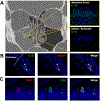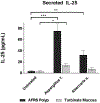Fungal extracts stimulate solitary chemosensory cell expansion in noninvasive fungal rhinosinusitis
- PMID: 30892837
- PMCID: PMC6640101
- DOI: 10.1002/alr.22334
Fungal extracts stimulate solitary chemosensory cell expansion in noninvasive fungal rhinosinusitis
Abstract
Background: Solitary chemosensory cells (SCCs) are rare epithelial cells enriched in nasal polyps and are the primary source of interleukin-25 (IL-25), an innate cytokine eliciting T-helper 2 (Th2) immune response. Although it is proposed that SCCs are stimulated by antigens released by upper airway pathogens, the exogenous triggers of human SCCs remain elusive. We studied patients with noninvasive fungal rhinosinusitis to determine whether extracts of Aspergillus fumigatus and Alternaria alternata stimulate SCC proliferation as an early event in type 2 inflammation.
Methods: Multicolor flow cytometry, immunofluorescence, and enzyme-linked immunoassay were used to interrogate mucosa from patients with mycetomas and allergic fungal rhinosinusitis (AFRS) for SCCs and IL-25. Primary sinonasal epithelial cells from AFRS patients and noninflamed inferior turbinates were stimulated with fungal extracts for 72 hours, and SCC population frequency as well as mitotic activity were quantified using flow cytometry.
Results: SCCs producing IL-25 are enriched in inflamed mucosa compared with intrapatient noninflamed control tissue (38.6% vs 6.5%, p = 0.029). In cultured sinonasal epithelial cells from AFRS nasal polyps, Aspergillus fumigatus and Alternaria alternata stimulated higher SCC frequency compared with controls (27.4% vs 10.6%, p = 0.002; 18.1% vs 10.6%, p = 0.046), which led to increased IL-25 secretion in culture media (75.5 vs 3.3 pg/mL, p < 0.001; 32.3 vs 3.3 pg/mL, p = 0.007). Ki-67 expression was higher in SCCs grown in fungal stimulation conditions compared with controls.
Conclusion: Although fungal antigens are known to potentiate immune response through innate cytokines, including IL-25, the early expansion of SCCs in the presence of fungus has not been described. This early event in the pathogenesis of noninvasive fungal rhinosinusitis may represent a target for intervention.
Keywords: IL-25; allergic fungal rhinosinusitis; fungal antigens; mycetoma; solitary chemosensory cells; type 2 inflammation.
© 2019 ARS-AAOA, LLC.
Figures




Similar articles
-
Solitary chemosensory cells are a primary epithelial source of IL-25 in patients with chronic rhinosinusitis with nasal polyps.J Allergy Clin Immunol. 2018 Aug;142(2):460-469.e7. doi: 10.1016/j.jaci.2018.03.019. Epub 2018 May 17. J Allergy Clin Immunol. 2018. PMID: 29778504 Free PMC article.
-
Superoxide dismutase reduces the inflammatory response to Aspergillus and Alternaria in human sinonasal epithelial cells derived from patients with chronic rhinosinusitis.Am J Rhinol Allergy. 2015 Mar-Apr;29(2):89-93. doi: 10.2500/ajra.2015.29.4155. Am J Rhinol Allergy. 2015. PMID: 25785747
-
Peripheral blood mononuclear cells from allergic fungal rhinosinusitis adults express a Th2 cytokine response to fungal antigens.Am J Rhinol Allergy. 2009 May-Jun;23(3):281-7. doi: 10.2500/ajra.2009.23.3311. Am J Rhinol Allergy. 2009. PMID: 19490802
-
Sinonasal solitary chemosensory cells "taste" the upper respiratory environment to regulate innate immunity.Am J Rhinol Allergy. 2014 Sep-Oct;28(5):366-73. doi: 10.2500/ajra.2014.28.4077. Am J Rhinol Allergy. 2014. PMID: 25198020 Review.
-
Allergic fungal rhinosinusitis.J Allergy Clin Immunol. 2018 Aug;142(2):341-351. doi: 10.1016/j.jaci.2018.06.023. J Allergy Clin Immunol. 2018. PMID: 30080526 Review.
Cited by
-
Revisiting the controversy: The role of fungi in chronic rhinosinusitis.Int Forum Allergy Rhinol. 2021 Nov;11(11):1577-1587. doi: 10.1002/alr.22826. Epub 2021 Jun 2. Int Forum Allergy Rhinol. 2021. PMID: 34076362 Free PMC article. Review.
-
Hydroxypropyl-Beta Cyclodextrin Barrier Prevents Respiratory Viral Infections: A Preclinical Study.Int J Mol Sci. 2024 Feb 8;25(4):2061. doi: 10.3390/ijms25042061. Int J Mol Sci. 2024. PMID: 38396738 Free PMC article.
-
Infection of Primary Nasal Epithelial Cells Grown at an Air-Liquid Interface to Characterize Human Coronavirus-Host Interactions.J Vis Exp. 2023 Sep 22;(199):10.3791/64868. doi: 10.3791/64868. J Vis Exp. 2023. PMID: 37811957 Free PMC article.
-
Extragustatory bitter taste receptors in head and neck health and disease.J Mol Med (Berl). 2024 Dec;102(12):1413-1424. doi: 10.1007/s00109-024-02490-0. Epub 2024 Sep 25. J Mol Med (Berl). 2024. PMID: 39317733 Free PMC article. Review.
-
Bitter taste receptor agonists regulate epithelial two-pore potassium channels via cAMP signaling.Respir Res. 2021 Jan 28;22(1):31. doi: 10.1186/s12931-021-01631-0. Respir Res. 2021. PMID: 33509163 Free PMC article.
References
Publication types
MeSH terms
Substances
Grants and funding
- R01 DC013588/DC/NIDCD NIH HHS/United States
- TL1TR001880 (to NNP)/TR/NCATS NIH HHS/United States
- R01DC013588 (to NAC)/Efficacy and Mechanism Evaluation Programme/International
- I01 CX001617/CX/CSRD VA/United States
- R01 AI095289/AI/NIAID NIH HHS/United States
- UO1AI125940 (to DRH)/Efficacy and Mechanism Evaluation Programme/International
- R01 GM083204/GM/NIGMS NIH HHS/United States
- R01AI095289 (to DRH)/Efficacy and Mechanism Evaluation Programme/International
- GM083204-08A1 (to DRH)/Efficacy and Mechanism Evaluation Programme/International
- U01 AI125940/AI/NIAID NIH HHS/United States
- TL1 TR001880/TR/NCATS NIH HHS/United States
LinkOut - more resources
Full Text Sources
Medical
Research Materials

